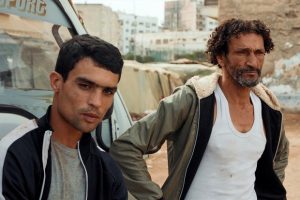Un Certain Regard: How (Not) To Get Lost In The Statement
Both critics and the public tend to affirm that, if there is something that cinema is currently struggling with, it is the lack of original stories and the excessive mass production that endlessly exposes the audience to reboots, remakes, and superhero movies.
However, these alleged threats are nothing more than a response from the big production companies that move the balance of the industry to achieve their main objective: to make money.
But (fortunately) it’s not all big Hollywood productions. And for those who are in search of new authors, new proposals, or precisely, new looks on cinema, the Un Certain Regard competition at the Cannes Film Festival is probably one of the main gold mines.
This year’s Un Certain Regard section included a total of twenty films. It opened with Thomas Cailley’s La règne animal and closed with Alex Lutz’s Strangers by Night. And while the feature films in competition had, as usual, their premieres at elegant gala screenings at the Grand Theatre Lumiere, the premieres of this section—founded in 1978 and only becoming competitive in 1998, with the aim of recognizing innovative, daring and aesthetically different works (often by first-time filmmakers)—had their first screenings in a humbler way at the Théâtre Claude Debussy.
To search for the matrix that festival programmers follow to compose the different sections and grids (which is never completely arbitrary or limited to formal criteria), to try to understand why certain films share a program—this may sound far-fetched, perhaps even unnecessary, but, nevertheless, it is interesting to know what the festival is trying to do by putting “this film with that film.”
In the case of Un Certain Regard at the 76th Cannes Film Festival, when evaluating the entire filmography of the competition, the intention is obvious, almost transparent, and, in fact, very risky. While many make claims about the threat of pre-sold franchises to the world of cinema, there is another much greater threat, and that is to turn cinema and films into a mere tool to make a statement loaded with political and ideological weight, rather than to tell a story manipulating (in the best possible sense) all the resources that the seventh art allows. But, surprisingly, despite the decision that the leitmotif of Un Certain Regard would be marked by the socio-political issues of different parts of the world and different times, the vast majority of the films in the selection manage to be just that, films that tell a story, and not simply an ideological statement that subordinates the art that gives it life.
Of course, not all of the films in the selection managed to do this effectively; or, they simply felt somewhat out of place in a selection with a fairly clear thread. Stéphanie Di Gusto’s Rosalie commits the sin of making a textbook, indifferent, and repetitive period recreation that rests on its discourse about a dysfunctional woman in a conservative era; Omen by the Congolese-born rapper-turned-filmmaker Baloji squanders possibly the most appealing idea of the entire selection—a film about different characters accused of witchcraft and sorcery—and turns it into a pretentious exposition of ideological discourses that have nothing to do in the film or in favor of the story it wants to tell; Warwick Thornton’s The New Boy puts on Cate Blanchett’s shoulders a story that wants to talk about so many things but ends up talking about none of them; and The Delinquents by Argentinian director Rodrigo Moreno is so hermetic and infatuated with itself that it forgets that giving the viewer a three-hour film implies a certain responsibility for a director, and should be worth every minute the viewer is sitting in that seat.

But while some fail to deliver their message, others shine with endearing stories and characters, as well as the technical quality of performance. The selection of Asian films in Un Certain Regard not only received the biggest ovations in the Debussy auditorium, but also affirmed the attention that should be paid to the cinema of those latitudes, something that was validated by the presence of Japanese master Hirokazu Kore-Eda in all the screenings. The Breaking Ice by Anthony Chen (China) confirms the ability of the previous winner of the Camera d’Or to build choral, intimate, and personal stories while exploring human relationships, depression, and polyamory. His compatriot Shujun Wei’s Only the River Flows brought noir to French theaters with the story of a detective obsessed with a murder that drives him to madness, while reflecting on the idea of storytelling itself. And if we are talking about noir, Kim Chang-hoon’s Hopeless (South Korea) provided the most entertaining, toughest, and possibly the best photographed experience of the entire competition, which serves as proof of the great achievement of Korean cinema in recent decades as it denounces the underworld life in South Korea, and how many innocent people are forced to enter a life guided by the illegal to survive, while the state turns a blind eye to their social problems. Meanwhile, If Only I Could Hibernate by Zoljargal Purevdash (Mongolia) tells the story of a poor young man in Mongolia who leaves all his dreams and goals aside to support his younger brothers, just like in Hopeless, in an environment that seems simply interested in fulfilling the quota of supporting whoever needs it as if they were numbers and not people, all this with a heartbreaking portrait of an alien and possibly unknown reality of a place in the world with a truly unknown filmography.

Without abandoning this idea of films that manage to make a statement while telling stories in a very effective way, these titles also appear in the selection: Kamal Lazraq’s debut feature Hounds, a co-production between Morocco, France, Belgium, Qatar and Saudi Arabia, the odyssey of a father and son who must also enter the world of crime to get by in the suburbs of Casablanca, except that unlike the previous films, Lazraq takes a twist and proposes a funny and irreverent account of the situation that makes us empathize even more with his characters; Mohamed Kordofani’s Goodbye Julia, the first Sudanese film to make it to Cannes, deserved recognition for its great performances set in the turbulent pre-secession era of South Sudan and which works first as an essay on secrets, motherhood, and interpersonal relationships, but also as a revolutionary act in itself by Kordofani in the face of the current situation in Sudan. And if we are talking about revolutionary acts, it would be impossible not to mention Terrestrial Verses by Ali Asgari and Alireza Khatami, who, with a vast experience in short films and a very distinctive cinematographic style (mainly in the case of Asgari), choose to abandon their conventions to make a film with a very different style, a film that oscillates between documentary and fiction, questioning the figure of authority in Iran, a country where the film was shot in secret and which, according to its directors, will probably not be released unless it is distributed through piracy due to the heavy censorship it has received.

Finally, the official jury awarded Molly Manning Walker’s British film How to Have Sex as the best film of the competition. With a shifting camera, tonal shifts from comedy to drama, and even certain sequences that send shivers through the body, the film tells the story of a young English girl facing the end of her adolescence and the beginning of her adult life during a summer vacation in which insecurities, toxic bonds, and the weight of the gaze of the other lead young people to expose themselves to completely naturalized traumatic situations.
The winner of the FIPRESCI award within the section, The Settlers by Felipe Gálvez (Chile), was the best expression of how to make a film loaded with ideological content, but without resting on what many would call—unfairly—”necessary and important.”
The story of The Settlers is set on the border of Chile and Argentina. José Menéndez has bought a large piece of land on the border of Chilean and Argentinean Patagonia, but in order to make use of it he must get rid of the indigenous people who inhabit it. That is where the main characters of the film, which is constructed as a western, come in. The Scottish MacLennan (Mark Stanley), Bill (Benjamin Westfall) and a mestizo native of the area, Segundo (Camilo Arancibia), who make up this functional and dysfunctional trio at the same time.
At first glance, The Settlers resorts to a minimalist approach to its mise-en-scene. There are a large number of general shots of establishing locations, long shots where the diegetic time is equal to the narrative time and makes us witness the action sequences in real time, and makes them feel quite isolated, since there is no montage that cuts over the action to change shot value; in many cases, we are shown everything from the same position, from start to finish.
But far from being an insipid mise-en-scène, these moments allow the film to force us to go through the whole frame to understand what is really happening, which are the characters involved in each scene, and constantly remind us that the characters are in a hostile territory and that, sooner or later, this environment will abandon its indifferent vibe in the face of this foreign presence. In this way, this minimalist proposal also shines in its production design and art direction, which together with Gálvez’s risky but functional decisions, make us contemplate each frame as if it were a period painting that invites us to dwell on the details.
As the story progresses, different chapters are identified that do not seek to fragment the story but to make the viewer take a certain stance towards the characters. It is at this point that the film becomes a western and not just another period drama. And not only because it is adorned with all the typical paraphernalia of a western, but because of how the journey of its characters, their relationships, isolation and the figure of authority and the supposed heroes of questionable morals make us enter this world.
Gálvez works a lot with the construction of different points of view and how they make the viewer relate to the characters, and with the imminent arrival of the most explicit violence in the last act.
There are many good directorial decisions in The Settlers that make it worthy of the award, but its greatest merit is the way that (in an ocean of empty statements and political and ideological discourses that were practically the only possible reading of many films) the winner of the FIPRESCI prize at Un Certain Regard joins a few others—such as The Zone of Interest, by Jonathan Glazer (which portrays the horror of World War II only through the use of sound and out-of-field), or the aforementioned Terrestrial Verses—in this idea of telling a story by taking advantage of the possibilities offered by cinema, and not placing all the weight of the film on the discourse underlying the script.
By Nicolás Medina
Edited by Robert Horton
© FIPRESCI 2023
